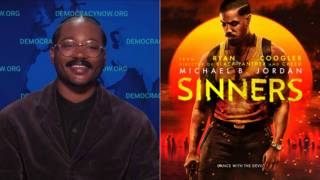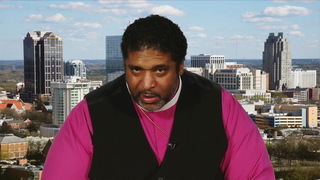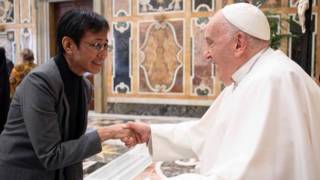
Guests
- Richard Cohenpresident of the Southern Poverty Law Center. He is co-author of an editorial published today in The New York Times titled “White Supremacists Without Borders.”
Church bells tolled Sunday and hundreds filled the church’s pews of the historic Emanuel AME Church in Charleston, South Carolina, for the first service since Dylann Roof’s attack on a Bible session in its basement last Wednesday. An estimated 20,000 people formed a Bridge to Peace unity chain on the Ravenel Bridge to show solidarity with his victims. A website discovered Saturday called “The Last Rhodesian” shows photographs of Roof at Confederate heritage sites and hosts a 2,500-word manifesto he is believed to have written that explains why he chose to carry out his mass murder spree. “Roof might have been a high school dropout, but he was an excellent student, it seems, of the white supremacist world,” says Richard Cohen, president of the Southern Poverty Law Center. He is co-author of an editorial published today in The New York Times titled “White Supremacists Without Borders.”
Transcript
AMY GOODMAN: Church bells tolled throughout Charleston, South Carolina, on Sunday for the nine victims of last week’s massacre by Dylann Roof at the historic Emanuel AME Church. Meanwhile, hundreds filled the church’s pews for the first service since the attack on a Bible session in its basement. On the altar, a black cloth covered the chair of Reverend Clementa Pinckney, one of Roof’s victims. Later Sunday evening in Charleston, an estimated 20,000 people formed a Bridge to Peace unity chain on the Ravenel Bridge to show solidarity with victims of the shooting. The church’s historian, Liz Alston, said the outpouring of support since the massacre is helping the congregation to heal.
LIZ ALSTON: I’m just so grateful that the community have poured out. I look at the flowers behind us and all of the love, and pouring out from the governor and the mayor on down, just kind of placated the congregation and gave us the faith, the fortitude, knowledge and the spirit to go on. That’s about all I can say.
AMY GOODMAN: On Friday, Dylann Roof appeared for his bond hearing before Charleston County Magistrate James Gosnell, who noted Roof’s family members were also victims in the attack, and said, quote, “We must find it in our heart … to help his family, as well.” It later emerged Judge Gosnell had been reprimanded by the state Supreme Court in 2005 for using a racial slur while on the bench. In 2003, he told a black defendant, quote, “There are four kinds of people in this world: black people, white people, rednecks, and [the N-word].” He actually used the word. A different judge will preside over Roof’s criminal charges.
At Friday’s hearing, relatives of Roof’s victims addressed him through a video monitor. He was in jail. This is Felicia Sanders, the mother of Tywanza Sanders, but first, Nadine Collier, the daughter of 70-year-old Ethel Lance.
NADINE COLLIER: You took something very precious away from me. I will never get to talk to her ever again. I will never be able to hold her again. But I forgive you, and have mercy on your soul. You hurt me. You hurt a lot of people.
FELICIA SANDERS: You have killed some of the most beautifullest people that I know. Every fiber in my body hurts, and I’ll never be the same. Tywanza Sanders was my son. But Tywanza was my hero. Tywanza was my hero. But as we say in Bible study, we enjoin you, but may God have mercy on you.
AMY GOODMAN: A website discovered Saturday called “The Last Rhodesian” shows about 60 photographs of Dylann Roof at Confederate heritage sites and slavery museums, and also hosts a 2,500-word manifesto he’s believed to have written that explains why he chose to carry out his mass murder spree at the historic Emanuel AME Church in Charleston. Roof wrote, quote, “I have no choice. I am not in the position to, alone, go into the ghetto and fight. I chose Charleston because it is most historic city in my state, and at one time had the highest ratio of blacks to Whites in the country. We have no skinheads, no real KKK, no one doing anything but talking on the internet. Well someone has to have the bravery to take it to the real world, and I guess that has to be me,” the manifesto said.
For more, we go Montgomery, Alabama, where we’re joined by Richard Cohen, president of the Southern Poverty Law Center, co-author, with Morris Dees, of an editorial published today in The New York Times titled “White Supremacists Without Borders.”
Welcome to Democracy Now!, Richard Cohen. Talk about what we know at this point about Dylann Roof.
RICHARD COHEN: You know, Roof might have been a high school dropout, but he was an excellent student, it seems, of the white supremacist world. His entry point was the website of the—I’m sorry. Can you hear me now?
AMY GOODMAN: I can hear you fine.
RICHARD COHEN: OK, someone was in my ear. I was saying that he may have been a high school dropout, but he was a good student, it seems, of the white supremacist world. His entry point was the Council of Conservative Citizens website. That’s a site that, you know, rails again and again about black-on-white crime, calls for white—it talks about white genocide. And, you know, Roof had adopted all of the symbols of the white supremacist world and was able to articulate them. So, to me, he seems like—to us, he seems like a classic example of someone who’s been radicalized not by going to hate group meetings, but by trolling the net and being involved in that echo chamber that is really quite so disturbing.
AMY GOODMAN: The manifesto believed to belong to Dylann Roof—and I’d like you to explain how it was registered and what it means—in it, he writes, quote, “Anyone who thinks that White and black people look as different as we do on the outside, but are somehow magically the same on the inside, is delusional. How could our faces, skin, hair, and body structure all be different, but our brains be exactly the same? This is the nonsense we are led to believe. Negroes have lower IQs, lower impulse control, and higher testosterone levels in generals. These three things alone are a recipe for violent behavior.” Again, these are the words of Dylann Roof. Richard Cohen?
RICHARD COHEN: Yeah. Well, again, you know, this is classic white supremacist garbage. The world knows that race is only skin deep. But for the white supremacist world, particularly something like the Council of Conservative Citizens, you know, race is destiny. And that’s a theme that one hears not just in this country, but in Europe, in South Africa. You know, right now, Amy, some of my colleagues are in an international conference in Budapest really to talk about the international character of the—of white ethnic nationalism. So, you know, what Dylann said, what Roof said, is really quite par from the course.
AMY GOODMAN: I want to turn to an excerpt from the short documentary White Power USA. It was made by independent filmmakers Rick Rowley and Jacquie Soohen in 2010 and aired in full on Al Jazeera English. This clip begins with Rowley, and then we hear from the Council of Conservative Citizens’ co-founder and CEO Gordon Baum.
RICK ROWLEY: The Council of Conservative Citizens is perhaps the largest and most influential white nationalist group pushing the envelope. The Council keeps its membership secret but counts elected officials among its ranks. It has dozens of chapters across the United States, many of which have organized tea parties. The organization is the descendant of the White Citizens’ Councils, formed to combat the civil rights movement and preserve segregation. Today, its website identifies the United States as a Christian and European nation, and opposes integration and race mixing.
GORDON BAUM: What’s a racist? You know, I’m not sure what the term means even. That you’re proud of what you are? Well, everybody, I guess, is a racist of some sort.
RICK ROWLEY: Gordon Baum was part of the White Citizens’ Councils in the ’60s. Today he is the Council of Conservative Citizens director.
GORDON BAUM: Our nose is being rubbed into the fact that Obama’s black, and we better all recognize the fact that he’s a black man and he’s our president. And, Mr. White American, you’re going to have your nose rubbed in it. We can do what we want, and we’re going to give ourself all kind of goodies. The last year has been probably our most dramatic in growth, because people are really upset with the direction this country has taken. And we’re getting lots of young people, a lot of veterans coming back from Iraq and Afghanistan, that want something done before it’s too late.
AMY GOODMAN: Now, that, again, Gordon Baum, who was the head of the Council of Conservative Citizens. He died this past year. Richard Cohen, talk about how this group fits into the white supremacist story.
RICHARD COHEN: Well, you know, as the little intro said, the Council of Conservative Citizens was built on the mailing list of the White Citizens’ Council, the notorious groups that tried to oppose integration. You mentioned earlier, Amy, in your headline roundup, that Earl Holt, the head of the White Citizens’—the head of the Council of Conservative Citizens, had donated money to political candidates. What’s much worse, in my view, has been the fact that the political figures, people in public office, have lent support to the Council of Conservative Citizens. Trent Lott, Bob Barr, Haley Barbour, the treasurer of the—the former treasurer in South Carolina, Mr. Patterson—they’ve all appeared at Council of Conservative Citizens events in the late ’90s and early 2000s. So, you know, we like to think of something like the Council of Conservative Citizens existing only on the margins of society; unfortunately, a group like that, particularly in the South, particularly among Republican candidates or officeholders, it also has a foothold in mainstream society.
AMY GOODMAN: What were you most struck by in this manifesto? This website, apparently, registered in February, and it went right to a few hours before the massacre on Wednesday, where he said he had to leave, he was in a hurry. But this 2,500-word manifesto, a lot has been made of this is a high school dropout who repeated—what was it? Ninth grade. What did you make of this manifesto?
RICHARD COHEN: A few points. First, you know, this young man was not stupid. He may have been a high school dropout, but, you know, it’s a fairly well-put-together diatribe. He is a lunatic, a psychopath, but he’s not an idiot. Secondly, you know, kind of at the end, he talks about “my life might not be worth more than a speck of dust, but I’m going to do something for the good of society. I’m the brave one.” And so what you see is someone who’s existing on the margins of life, not successful in the real world, so he retreats to the world of the web and decides, instead of being a down-and-out kid with no future, he is going to do something heroic for the white race. I mean, I think that’s the main takeaway.
AMY GOODMAN: How did he get involved with white supremacist movements, or movement?
RICHARD COHEN: Well, you know, I’m not 100 percent sure. He talks about how the Trayvon Martin case—you know, he became aware of it and then began to search on Google for black-on-white crime and came to the Council of Conservative Citizens website, which gave him an explanation for his own failures in life, right? You know, it’s black people are trying to take over the world; black-on-white crime is the real problem; look at South Africa, you know, it’s—there’s the white genocide going on there. And that fit into—you know, Roof adopted those views, became more and more radical, and eventually decided to strike out. We’ve seen this kind of pattern before of people going to the echo chamber of the web, getting angrier and angrier and angrier, and eventually striking out. Earlier this year, we put out a report about lone wolves. And, you know, it’s a very familiar pattern that we’ve seen many times.
AMY GOODMAN: Roof allegedly justified the massacre by saying you’re raping our women.
RICHARD COHEN: Yeah.
AMY GOODMAN: How does this fit into the larger ideology of white supremacy?
RICHARD COHEN: Well, I mean, first, you go back to The Birth of a Nation, right? the film in the early part of last century, where that bugaboo was one of the animating features of the film. You know, hundreds, if not thousands, of black men over—historically, have been lynched on allegations such as that. And, of course, if you go to the Council of Conservative Citizens website, again and again it’s this, you know, black men are raping white women, black men are committing crimes against white people. So it’s a trope that has been a constant for more than a century in the white supremacist world.
AMY GOODMAN: We want you to stay with us, Richard Cohen, president of the Southern Poverty Law Center, co-author of an editorial published in today’s New York Times headlined “White Supremacists Without Borders.” When we come back, Kevin Alexander Gray will join Richard Cohen. He’s speaking to us from South Carolina’s capital, Columbia. Stay with us.













Media Options